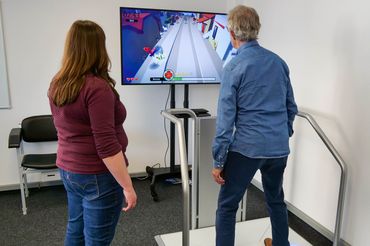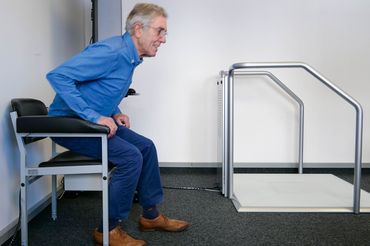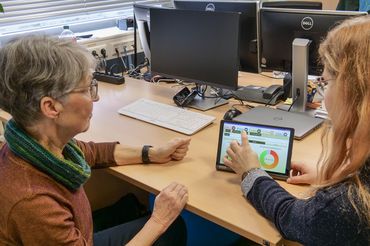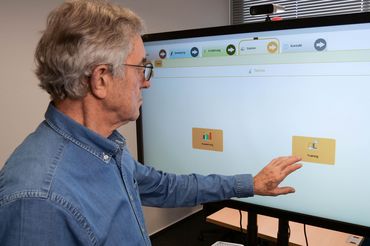AS-Tra
Contact AS-Tra study team
Head of study
Study team
![BMBF_CMYK_Gef_M [Konvertiert]](/f/6/_processed_/3/2/csm_BMBF_gefoerdert_2017_en_9d9a3028e0.jpg)
AS-Tra
Assistance System for sustainable improvement of nutritional and mobility status of older people under consideration of the Transtheoretical Model of health behaviour change
Background
Many older people suffer from deficits in nutritional and physical activity status, two mutually interacting elements that often go unrecognised for a long time in standard health care. Interventions such as physical and/or nutritional therapies often only take effect when deficits have already manifested themselves; moreover, physical training of older people is rarely coordinated with nutritional therapy interventions and psychological models for the sustainability of behavioural change are rarely taken into account. A good nutritional and physical activity status is the basis for the prevention of falls, which often leads to the need for care or a reduced quality of life. An addition to standard care therefore appears to be useful to make it easier for older adults to optimise their nutrition and physical activity behaviour or to stabilise it at a good level.
Approach
In the "AS-Tra" project, a technical assistance system is being developed and evaluated with the help of a user-centred approach involving older people aged 70 and over. The system offers possibilities for independent exercise and nutrition testing and thus for early detection of possible risks through two elements: a tablet-based app and an assessment and training station for independent use. The personalised intervention promotes healthy eating and physical activity behaviour by taking into account the Transtheoretical Model of Behaviour Change by DiClemente and Prochaska, in which the content is adapted to the needs and goals of the senior citizens.
The project "AS-Tra" is divided into three sub-studies:
First, the measurement and training station as well as the tablet-based app are to be developed or completed. In order to achieve a high level of usability and to align the development with the needs of the target group, senior citizens will be involved in the development in the form of focus group discussions and piloted usage studies.
In the third sub-study, the optimised assistance system is used by the target group for 12 weeks in a two-armed randomised controlled survey. Possible sustainable behavioural changes of the elderly as well as effects on the nutritional and physical activity status of the intervention group vs. a control group receiving standard care will be recorded. The plan to test the assistance system in the long term will also provide valuable insights into the barriers older people face when using modern technology.
Throughout the project, possible approaches for the implementation of technical assistance in the health care of seniors will be discussed with relevant stakeholders from the health care sector in regular workshops. This is to ensure that the assistance system can be integrated into the existing health care system in the best possible way and that it is also considered useful and suitable for use by experts in geriatrics, nutrition and physiotherapy, for example.
Advisory board
What is the advisory board?
Our project advisory board plays an important role in the AS-Tra project. As an advisory board, it ensures that the research meets the needs and interests of the target group - older people over 70 with nutritional and/or mobility deficits. In contrast to the study participants, the members of the advisory board are actively involved in the research and conduct research together with the study team.
In our project, we have established a project advisory board with nine committed members over the age of 70. Since December 2022, we have already held four meetings in which we were able to benefit from their valuable input. Working with the advisory board enriches our research and ensures that it has a positive impact on society.
The tasks of the advisory board include optimizing the experimental design, advising on the implementation of the study, interpreting the results and reviewing the information materials. With their expertise and experience, they help to ensure that the measurement and training station and the associated app are accessible to older people and that meaningful results can be delivered.
Interim result
Publications
Förster M., Happe L., Quinten V., Diekmann R. (2023, Juli) AS-Tra – Entwicklung eines technischen Assistenzsystems zur Verbesserung von Ernährung und Mobilität im Alter. Posterbeitrag beim gemeinsamen Workshop von ITG und Plattform-Charité Versorgungsforschung zur Digitalisierung der Gesundheitsversorgung älterer Menschen
Diekmann R., Happe L., Sgraja M. Quinten V., Hein A. (2023, September) Qualitative Bedarfsanalyse zu Elementen einer Mess- und Trainingsstation für Personen über 70 Jahren mit Risiko für Mangelernährung und Mobilitätsdefiziten - eine Fokusgruppenstudie. Vortrag auf dem 35. Jahreskongresses der Deutschen Gesellschaft für Geriatrie. (2023). Zeitschrift fur Gerontologie und Geriatrie, 56(Suppl 2), 25–99. https://doi.org/10.1007/s00391-023-02223-x
Happe L., Förster M., Quinten V., Diekmann R. (2023, September) Iterative Development and Applicability of a Measurement and Training Station for Older Adults to Independently Assess and Improve Nutrition and Mobility. Posterbeitrag auf dem 19th Congress of the European Geriatric Medicine Society. Eur Geriatr Med 14 (Suppl 1), 1–387 (2023). https://doi.org/10.1007/s41999-023-00883-x
Happe L., Sgraja M., Quinten V., Diekmann R. (2023, November) Welche Gesundheitsdaten und Trainingsformen bevorzugen ältere Menschen mit Ernährungs- und Mobilitätsdefiziten in einer eigenständig nutzbaren Mess- und Trainingsstation? Eine qualitative Fokusgruppenstudie. Vortrag auf dem auf dem Forschungssymposium Physiotherapie (FSPT)






